The Uncomfortable Truth Behind Carney's Grimace: When Handshakes Reveal More Than Diplomacy
Analysis of Canadian PM Mark Carney's visibly uncomfortable handshake with Korean President Lee Jae Myung at APEC 2025—and the documented institutional failures, falsified partnerships, and traffic analytics proving Canada knew about Korea's systematic problems before signing major defense agreements.
October 30, 2025
Update (November 7, 2025): This analysis of Canada's knowledge regarding institutional concerns has been expanded with a comprehensive examination of the Canadian Patrol Submarine Project's operational and industrial challenges. The new analysis reveals how Hanwha Ocean's simultaneous pursuit of nuclear submarine development—while South Korea's STEM talent pool collapses—compounds the procurement risks documented here. See: Canada's Arctic Sovereignty Crisis: Why Diesel-Electric Submarines Can't Defend What Nuclear Subs Could Protect
Three Handshakes, Three Stories
At the 2025 APEC summit in Gyeongju, three diplomatic handshakes revealed starkly different levels of comfort. President Lee Jae Myung's grip with Donald Trump was firm, his posture confident as he presented the American president with a golden crown. His clasp with Japanese Prime Minister Sanae Takaichi was warm and professional—two leaders comfortable engaging with each other.
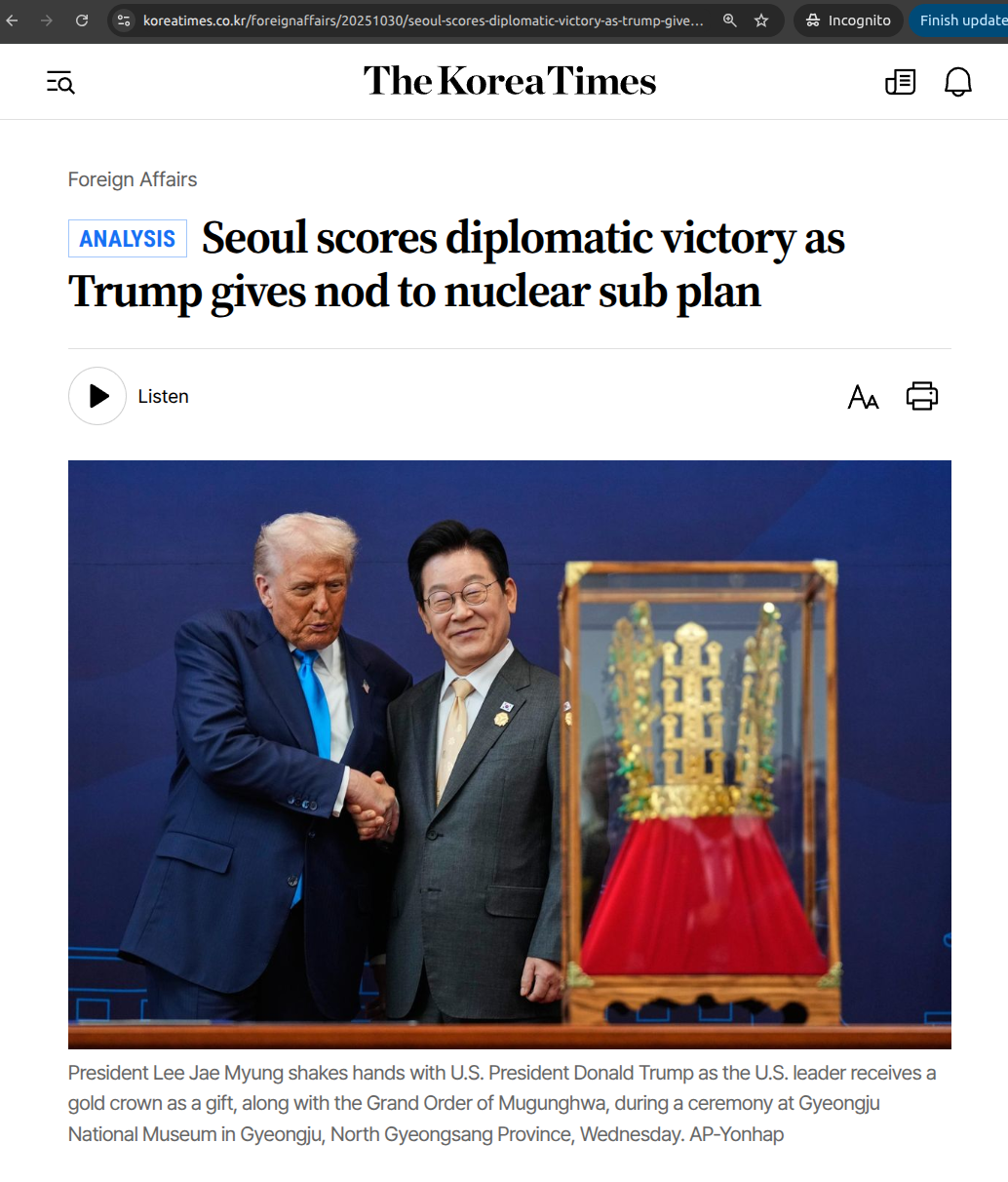 President Lee Jae Myung shakes hands with U.S. President Donald Trump as the U.S. leader receives a gold crown as a gift, along with the Grand Order of Mugunghwa, during a ceremony at Gyeongju National Museum in Gyeongju, North Gyeongsang Province, Wednesday. AP-Yonhap
President Lee Jae Myung shakes hands with U.S. President Donald Trump as the U.S. leader receives a gold crown as a gift, along with the Grand Order of Mugunghwa, during a ceremony at Gyeongju National Museum in Gyeongju, North Gyeongsang Province, Wednesday. AP-Yonhap
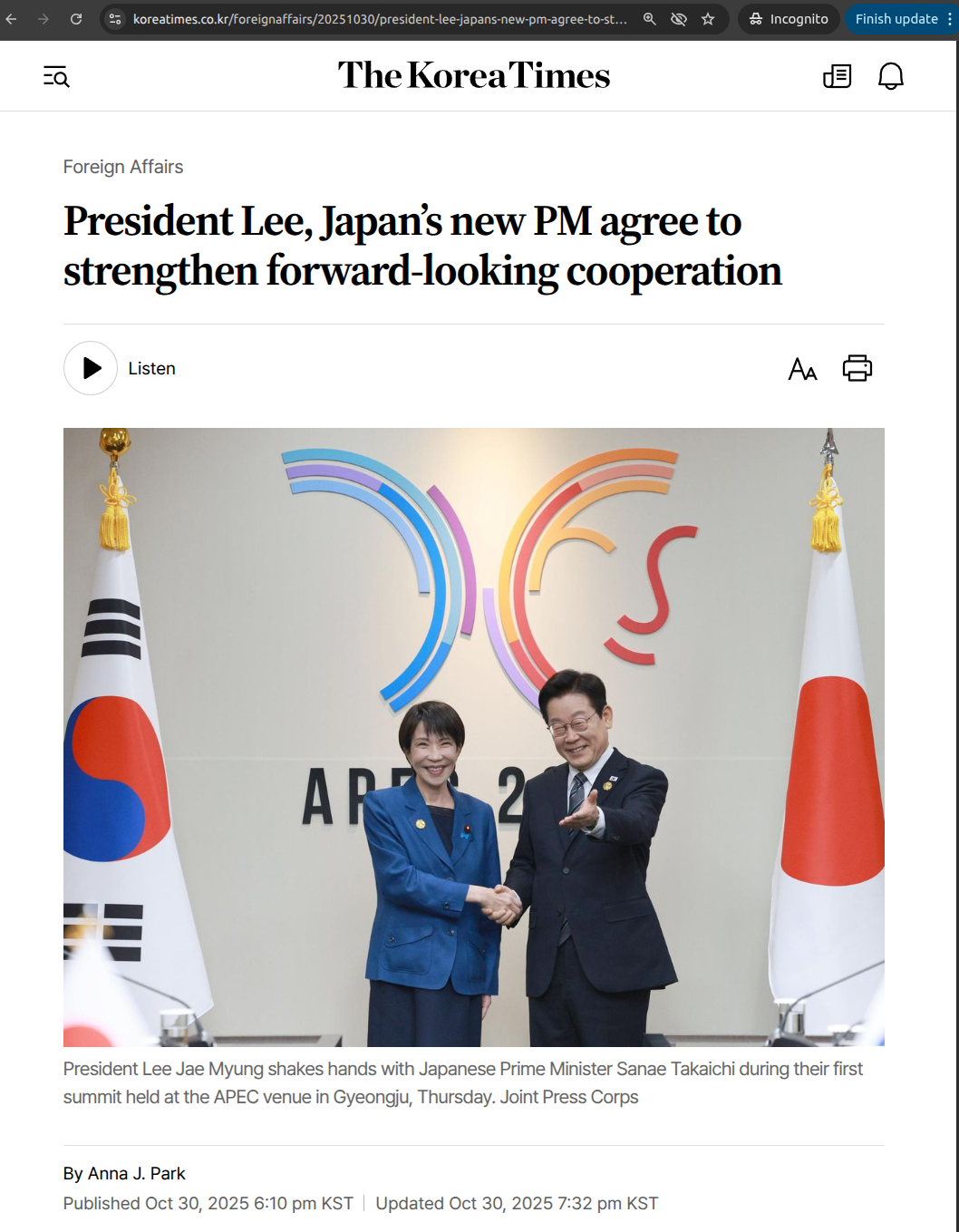 President Lee Jae Myung shakes hands with Japanese Prime Minister Sanae Takaichi during their first summit held at the APEC venue in Gyeongju, Thursday. Joint Press Corps
President Lee Jae Myung shakes hands with Japanese Prime Minister Sanae Takaichi during their first summit held at the APEC venue in Gyeongju, Thursday. Joint Press Corps
But when Canadian Prime Minister Mark Carney extended his hand to Lee, everything changed.
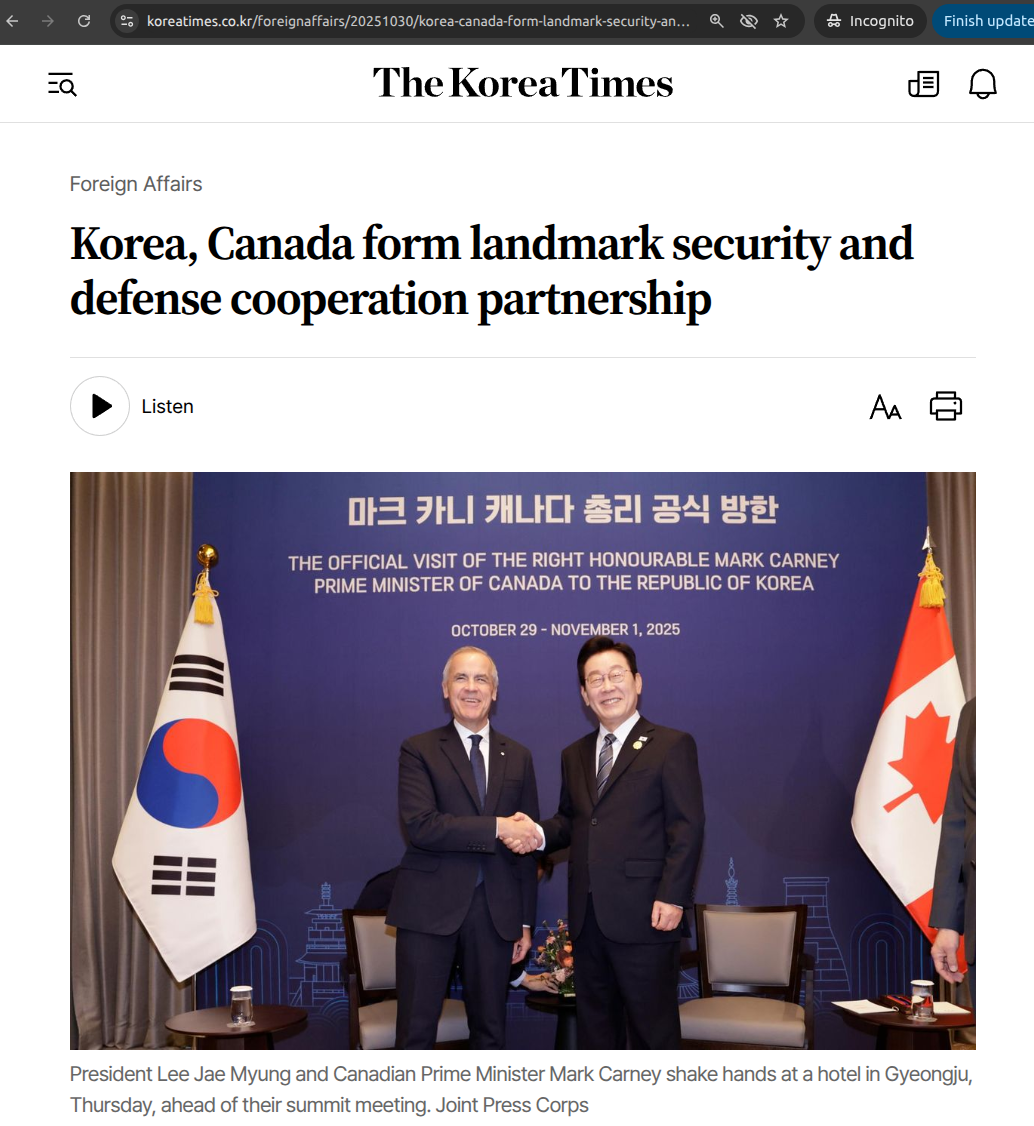 President Lee Jae Myung and Canadian Prime Minister Mark Carney shake hands at a hotel in Gyeongju, North Gyeongsang Province, Thursday, ahead of their summit meeting. Joint Press Corps
President Lee Jae Myung and Canadian Prime Minister Mark Carney shake hands at a hotel in Gyeongju, North Gyeongsang Province, Thursday, ahead of their summit meeting. Joint Press Corps
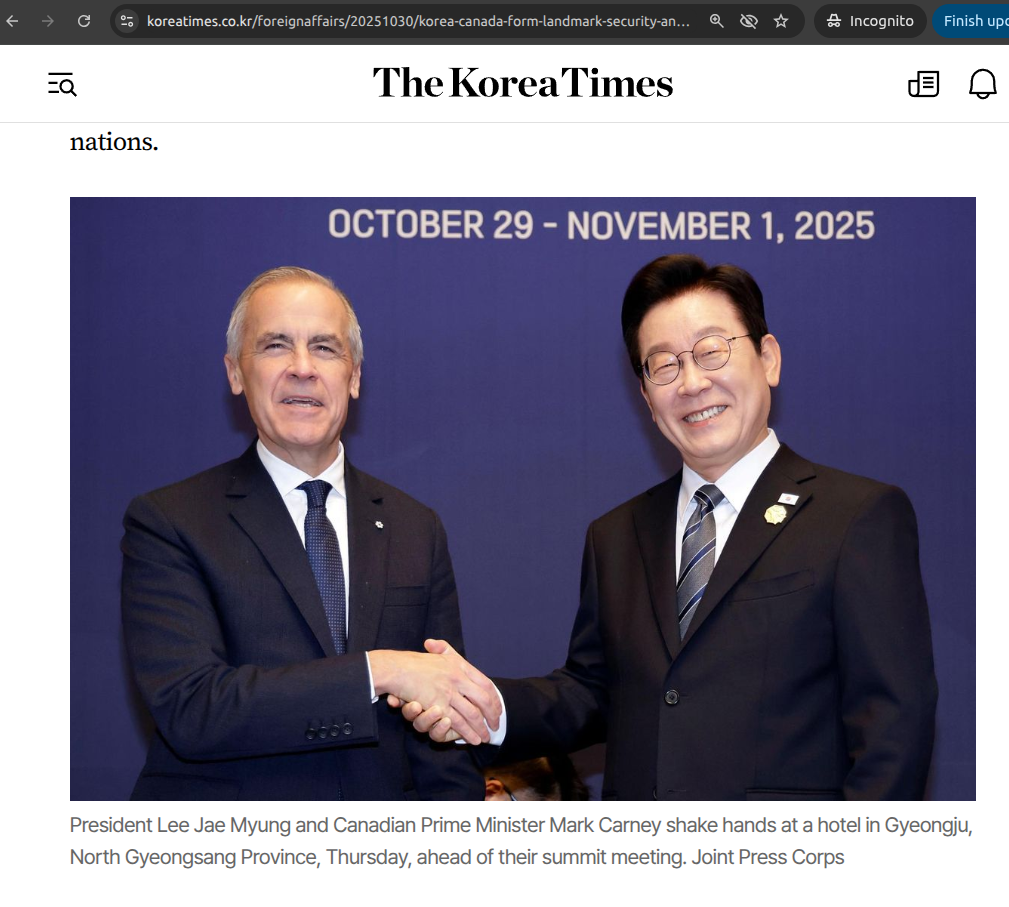 Close-up reveals Carney's visible discomfort: the grimace, the limp handshake, the body language of a leader who knows uncomfortable truths.
Close-up reveals Carney's visible discomfort: the grimace, the limp handshake, the body language of a leader who knows uncomfortable truths.
The photo captures what words cannot: Carney's grimace, his visible discomfort, the awkward body language of a leader forced to perform diplomatic protocol while knowing uncomfortable truths. His hand looks like a limp dead fish being held by Lee—he's not gripping Lee's hand at all. This wasn't diplomatic fatigue or cultural misunderstanding. This was the handshake of a prime minister who knows too much.
What Canada Knows: The Dongguk File
The Canadian government, including Global Affairs Canada (GAC) and the Canadian Embassy in Seoul, has been comprehensively briefed on systematic institutional integrity failures at Korean universities—specifically Dongguk University, whose Gyeongju campus is in the very city hosting APEC.
The Falsified Partnerships
On April 5-6, 2025, we contacted Canadian universities about falsified partnerships listed on Dongguk University's official website. The response was damning:
University of British Columbia (UBC): Dongguk lists UBC as a partner institution on their official partners page.1 However, UBC's official "Current partnerships" page does not list Dongguk University under the South Korea section.2 We have archived evidence of both pages proving this discrepancy.
Anonymous Canadian University: At least one other Canadian institution confirmed directly to us: "We do not have a student exchange agreement with Dongguk University" but requested media anonymity.3 This demonstrates Canadian institutions are aware of the fraud but unwilling to publicly acknowledge it.
The 40% Fraud Rate: Of the five Canadian partnerships we verified on Dongguk's website, two were confirmed false or disputed—a 40% fraud rate in claimed international partnerships with a single country.
The Diplomatic Acknowledgment
On April 27, 2025, we notified the Canadian Embassy in Seoul and Global Affairs Canada about the partnership fraud and sexual violence crisis in Korean higher education. The Canadian diplomat's response acknowledged our concerns as a "sensitive matter."4
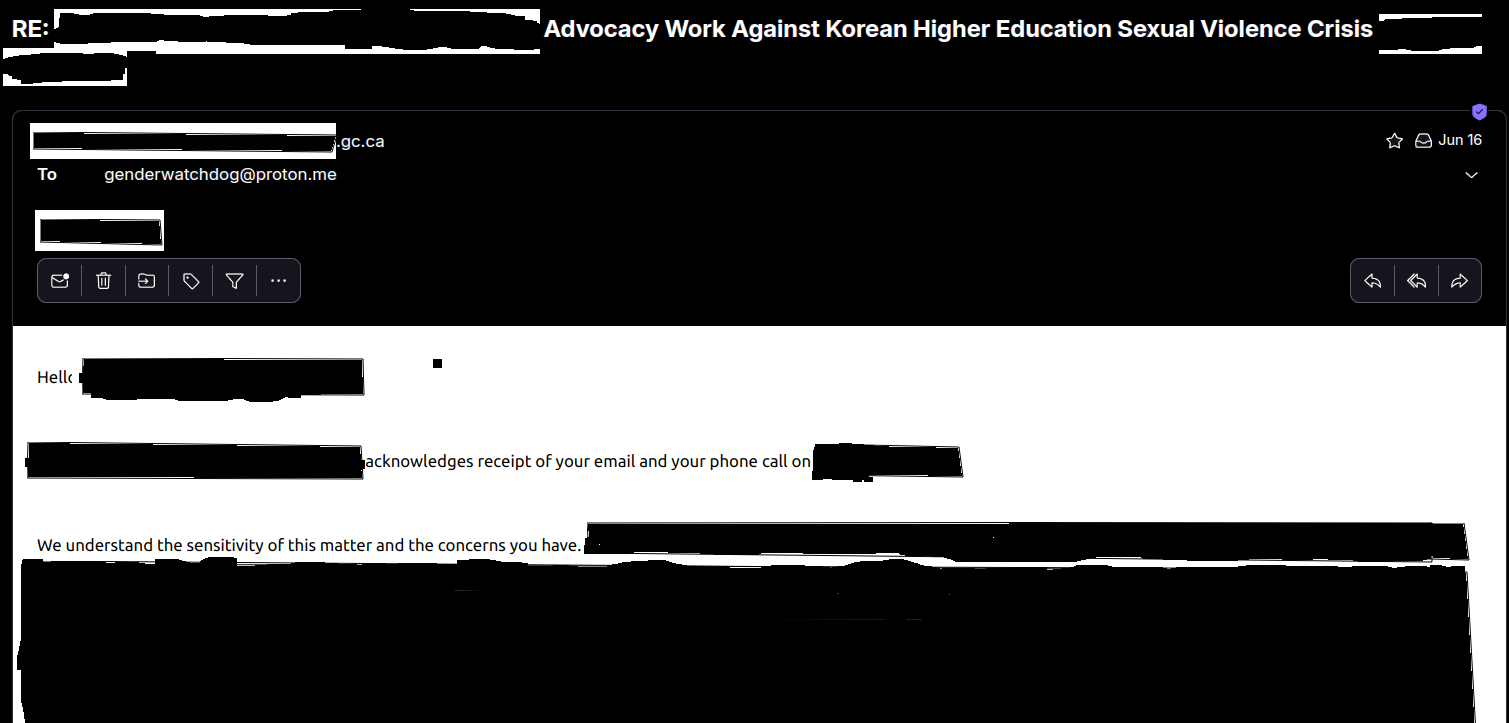 Canadian diplomat's June 16, 2025 response acknowledging partnership fraud and sexual violence concerns as "sensitive matter" - redactions ours to protect privacy
Canadian diplomat's June 16, 2025 response acknowledging partnership fraud and sexual violence concerns as "sensitive matter" - redactions ours to protect privacy
This diplomatic language confirms that by June 2025—four months before Carney's APEC handshake—the Canadian government understood that:
- Korean universities were falsifying Canadian partnerships
- Sexual violence cover-ups were systemic in Korean higher education
- International student safety mechanisms had failed
- The issues carried diplomatic implications
The Predatory Appointment That Canada Knew About
The "sensitive matter" included documentation of perhaps the most disturbing institutional arrangement at Dongguk: Tcha Sung-Jai (차성재), founder and co-CEO of Sidus FNH (a major Korean entertainment company), secured an appointment as a "French instructor" at Dongguk's Graduate School of Digital Image & Contents—the very institution where his company maintains shared campus facilities.5
Why This Matters:
Tcha simultaneously holds:
- Corporate control: Founder/Co-CEO of Sidus FNH, one of Korea's top five film production companies
- Academic authority: Faculty member with direct control over student grades and thesis approvals
- Industry gatekeeping: Controls access to entertainment industry internships and jobs
- Industry association presidency: President of the Korea Film Producers Association, controlling professional standards industry-wide
This creates a quadruple dependency trap where students cannot report concerns about their "instructor" without risking academic retaliation, corporate blacklisting, industry-wide exclusion, and legal intimidation from both corporate and association resources.
The "French" Deception: Why would an entertainment company CEO be teaching French language at a Korean film program? Our April 2025 correspondence to Dongguk exposed the suspicious curriculum: the program emphasizes French while offering no English training—despite English being the dominant language in global cinema for international co-productions, grants, festivals, and industry networking.5
The appointment appears designed to provide academic legitimacy for predatory access rather than serve any genuine educational purpose. When curriculum makes no professional sense, it suggests the program exists to enable exploitation rather than education.
Important clarification: While KT (a Korean telecommunications conglomerate) acquired Sidus FNH in 2005, Tcha did not become CEO of KT. He remained with Sidus as co-CEO and founder, maintaining his entertainment industry role and Korea Film Producers Association presidency—the positions that create the predatory access structure when combined with his "French instructor" appointment at Dongguk.5
Legal Threats: Sidus FNH issued defamation threats against us for documenting this arrangement, demonstrating how Korea's criminal defamation law—which criminalizes truthful testimony—functions as a systematic silencing mechanism protecting institutional capture.5
Canada knew all of this when Carney shook Lee's hand.
The Defense Monitoring: Traffic Analytics Don't Lie
Beyond diplomatic briefings, we have objective evidence that the Canadian defense establishment was actively monitoring our documentation about Korea's institutional integrity failures.
On August 27, 2025, we posted an X.com warning about Hanwha's bidding on Canada's $20-24 billion submarine procurement program,6 calling for enhanced due diligence given human rights and institutional capture concerns in Korean defense partnerships.
The Response:
On August 29, 2025—just 48 hours later—our blog analytics spiked to 129 views, representing a 10x increase over our normal baseline of 2-15 views per day.7
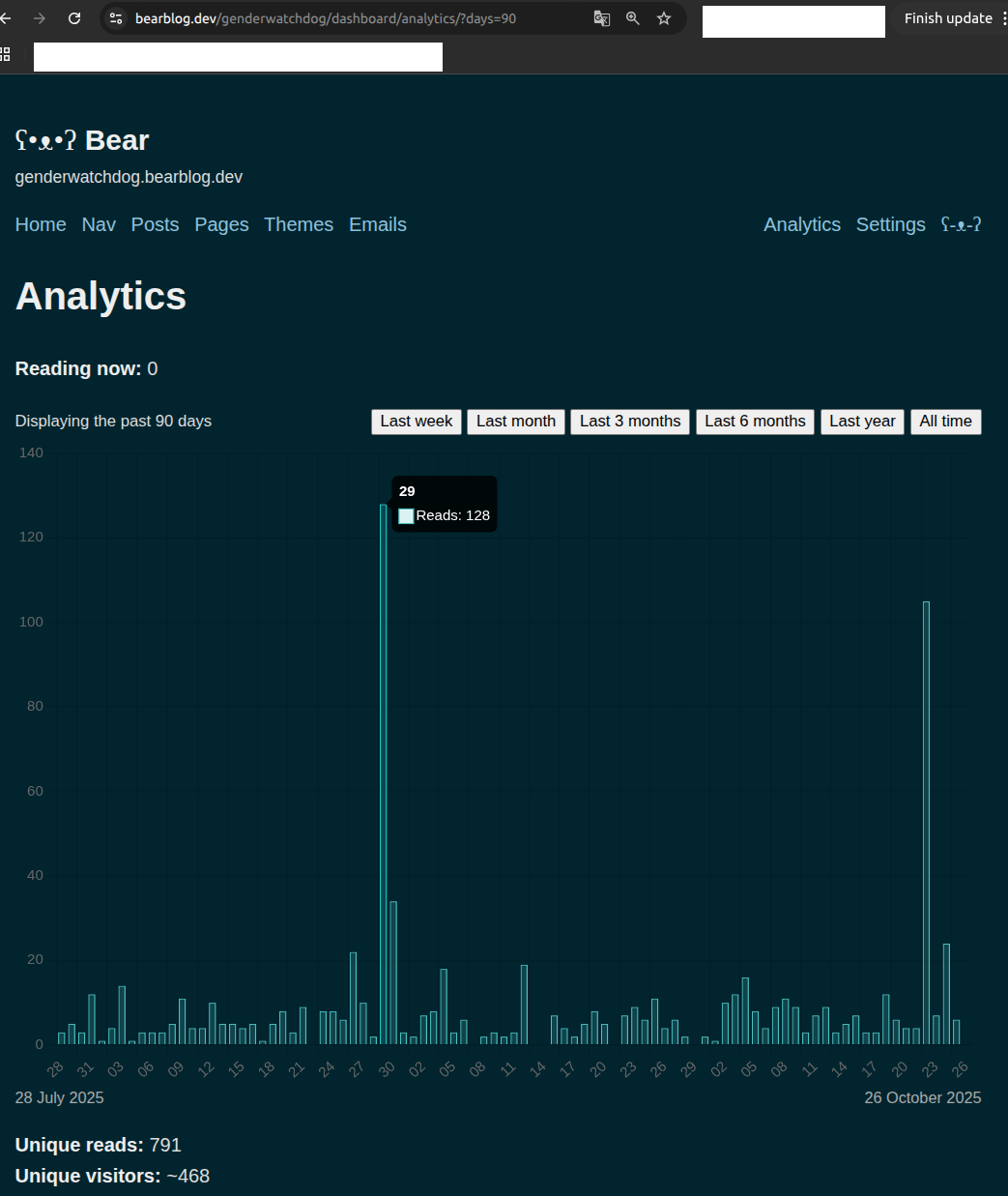 Blog traffic spiked to 129 views (10x baseline) on August 29, 2025—48 hours after X.com warning about Hanwha submarine contract
Blog traffic spiked to 129 views (10x baseline) on August 29, 2025—48 hours after X.com warning about Hanwha submarine contract
This spike occurred during a documented four-month surveillance pattern (June-October 2025) where viewers arrived within seconds of publishing, using VPN exit nodes (primarily Czech Republic, Israel, Japan) to obscure organizational origin. We exposed this surveillance publicly with screen-recorded video evidence that received 400+ views, proving the monitoring pattern had become widely known.7
What This Proves:
The timing (48 hours after tagging Canadian government agencies) and magnitude (10x baseline) establish that someone with authority directed multiple personnel to systematically review our documentation about Hanwha. This isn't organic social media engagement—the X.com post itself had modest public interaction. This is institutional research triggered by accountability documentation.
At baseline 2-15 views/day, it would take 8-65 days to accumulate 129 views organically. Receiving them in a single day, immediately after warning about submarine procurement risks, proves Canadian defense establishment monitoring.
The anonymous VPN access demonstrates that institutional actors recognized the documentation's sensitivity and deliberately obscured their affiliation while conducting due diligence.
The Handshake That Couldn't Hide the Truth
Later on the same day Carney grimaced through his handshake with Lee, the Canadian prime minister and Defense Minister David McGuinty visited Hanwha Ocean's Geoje shipyard to inspect submarine construction, accompanied by Korean Prime Minister Kim Min-seok.8 The visit aimed to assess production capabilities for the very Canadian Patrol Submarine Project (estimated at $20-24 billion USD for 12 submarines) we had warned about months earlier.6
Think about the cognitive dissonance Carney was managing:
What Canada knew:
- Dongguk University falsified 40% of verified Canadian partnerships (200+ days of institutional silence)
- Canadian diplomat acknowledged systematic issues as "sensitive matter" (no public advisory issued)
- Entertainment company CEO occupies predatory teaching position with quadruple dependency control
- Defense establishment monitored our warnings (proven by traffic analytics)
- Sexual violence cover-ups systemic in Korean higher education (part of "sensitive matter")
What Canada did anyway:
- Signed "ROK-Canada Security and Defence Cooperation Partnership"—Canada's first such agreement in Indo-Pacific8
- Conducted submarine shipyard inspection at Hanwha Ocean
- Maintained public posture of strengthening strategic partnership
- Issued no public advisory about institutional integrity concerns
This is institutional capture at the international level: defense establishments conduct private due diligence (proven by our traffic analytics showing immediate monitoring response) while maintaining public partnerships that legitimize compromised institutions.
Carney's grimace wasn't diplomatic protocol failing. It was the involuntary physical manifestation of a leader who understands he's shaking hands with a system his government knows is corrupt—and choosing strategic expediency anyway.
Why This Matters Beyond One Handshake
The traffic analytics provide objective proof of a pattern that extends beyond diplomatic discretion into documented institutional behavior:
Pattern documented across three campaigns:7
- Hanwha submarine warning (Aug 27): 129 views (10x spike) following X.com post to Canadian government
- ADEX arms expo email campaign (Oct 22): 105 views (7-10x spike) during outreach to 135 defense industry recipients
- APEC press outreach (Oct 29-30): 20+ visitors averaging 5 pages per session (deep research behavior)
The consistency demonstrates this isn't coincidence—it's systematic institutional monitoring of accountability documentation. When institutions go to operational lengths to anonymize their traffic while conducting comprehensive research, they're revealing their recognition of the material's credibility and implications.
The real question: If Canadian institutions are monitoring our documentation closely enough to trigger 10x traffic spikes within 48 hours, conducting multi-page research sessions, and acknowledging concerns as "sensitive matters"—why are they simultaneously signing major defense partnerships with the very institutions they're privately investigating?
Carney's grimace captured the moment when doing the right thing conflicts with strategic necessity, and strategic necessity wins. But unlike diplomatic cables that remain classified, traffic analytics don't lie. We can prove they knew.
The handshake photograph will fade from news cycles. The archived analytics proving institutional monitoring will remain as evidence that every major Canadian defense partnership with Korea was signed with full knowledge of systematic institutional fraud.
That grimace told the truth Carney's words and signature couldn't.
Related Coverage
For comprehensive documentation of the institutional monitoring pattern: 📊 Traffic Spike Evidence: Pattern of Institutional Monitoring Across Arms Export Campaigns
For the complete surveillance and censorship timeline: 🚨 Six-Month Surveillance and Censorship Timeline
For APEC censorship evidence: 📹 APEC Censorship Evidence: Three Documented Incidents
This analysis is based on verified documentary evidence including diplomatic communications (redacted for privacy but available to oversight bodies), timestamped traffic analytics, partnership verification through institutional websites, and public statements. All traffic data is archived and independently verifiable. We maintain comprehensive evidence files for all claims made in this analysis.
Contact: genderwatchdog@proton.me
Evidence repositories:
- Blog source + evidence: https://github.com/Gender-Watchdog/blog.genderwatchdog.org-mirror (see
assets/folder) - Surveillance archive: https://github.com/Gender-Watchdog/genderwatchdog_metookorea2025 (see
email_emls/andimgs/folders)
-
Dongguk University, "Partners" page listing UBC among partner institutions. Live page: https://www.dongguk.edu/eng/page/554 Archive: https://web.archive.org/web/20250408154026/https://www.dongguk.edu/eng/page/554 -
University of British Columbia, "Current partnerships" page, South Korea section does not list Dongguk University. Live page: https://global.ubc.ca/partner-ubc/current-partnerships Archive: https://archive.md/jdNOp -
Gender Watchdog, "Second Falsified Partnership on Dongguk University's Website: UBC Not Listed by UBC — 150+ Days of Silence," blog post documenting partnership fraud and institutional silence across two countries, September 2, 2025. Available at: https://blog.genderwatchdog.org/second-falsified-partnership-on-dongguk-universitys-website-ubc-not-listed-by-ubc-150-days-of-silence/ ↩
-
Gender Watchdog, "Canadian Diplomat 'Sensitive Matter' Acknowledgment," X.com post with screenshot of redacted email from Canadian Embassy, June 16, 2025. Available at: https://x.com/Gender_Watchdog/status/1959510392465698985 (Note: Redactions are ours to protect privacy. Full unredacted materials available to responsible ministers and Auditor General under confidentiality.) ↩
-
Gender Watchdog, "The Alleged Predatory Appointment and Government Cover-Up: How IEQAS Certification Enables Systematic Corporate-Academic Exploitation at Dongguk University," blog post documenting Tcha Sung-Jai's quadruple dependency structure and Sidus legal threats, September 23, 2025. Available at: https://blog.genderwatchdog.org/the-alleged-predatory-appointment-and-government-cover-up-how-ieqas-certification-enables-systematic-corporate-academic-exploitation-at-dongguk-university/ ↩ ↩2 ↩3 ↩4
-
Canada's National Observer, "Carney tours Korean shipyard vying to build Canada's next submarine fleet," October 30, 2025. Available at: https://www.nationalobserver.com/2025/10/30/news/carney-tours-korean-shipyard-vying-build-canadas-next-submarine-fleet Breaking Defense, "Canada names Hanwha, Thyssenkrupp as 'qualified suppliers' for new submarine program," August 2025. Available at: https://breakingdefense.com/2025/08/canada-names-hanwha-thyssenkrupp-as-qualified-suppliers-for-new-submarine-program/ (Note: Hanwha estimates 12 submarines at $20-24 billion USD; some Canadian sources cite overall program costs up to $100 billion CAD including infrastructure and lifecycle costs.) -
Gender Watchdog, "Traffic Spike Evidence: Pattern of Institutional Monitoring Across Arms Export Campaigns," blog post documenting 10x traffic increases following Hanwha submarine warnings and systematic surveillance patterns, October 29, 2025. Available at: https://blog.genderwatchdog.org/traffic-spike-evidence-institutional-monitoring-arms-export-campaigns/ ↩ ↩2 ↩3
-
Anna J. Park, "Korea, Canada form landmark security and defense cooperation partnership," Korea Times, October 30, 2025. Available at: https://www.koreatimes.co.kr/foreignaffairs/20251030/korea-canada-form-landmark-security-and-defense-cooperation-partnership ↩ ↩2